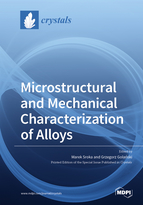Microstructural and Mechanical Characterization of Alloys
A special issue of Crystals (ISSN 2073-4352). This special issue belongs to the section "Inorganic Crystalline Materials".
Deadline for manuscript submissions: closed (30 April 2020) | Viewed by 26334
Special Issue Editors
Interests: steel; alloys; mechanical properties; precipitates; microstructure; welded joints, creep; heat treatment
Special Issues, Collections and Topics in MDPI journals
Interests: steel; heat treatment; mechanical properties; precipitates; welded joints
Special Issues, Collections and Topics in MDPI journals
Special Issue Information
Dear Colleagues,
The crucial stage when designing constructions and appliances is the choice of a proper grade of engineering material with the required functional properties. Currently, engineers can choose from four basic groups of engineering materials, including: Metals and their alloys, ceramics, polymers, and composites. A set of specific mechanical and physical properties decides on the common use of metals and alloys as materials for construction, tools, or specific purposes. The deciding factor is also the easiness of forming with the use of casting methods, cold and hot working, as well as the possibility of joining metal elements by welding, pressure welding, soldering, gluing, etc. and the affordable price. Mechanical properties of alloys are determined by the type of the metal microstructure, characterized by the chemical composition and the crystalline structure of phases, the size and shape of grains of the particular phases and their mutual distribution, the extent of crystal lattice defects, and the way of spacial distribution of the defects. The microstructure of alloys is shaped through building a proper chemical composition and selecting the right conditions of the applied heat, thermochemical or plastic treatment.
We invite researchers to submit papers related to alloys (engineering materials) to discuss potential materials, the method of improvement of strength and cyclic properties of alloys, the stability of microstructures, the possible application of new (or improved) alloys, and the use of treatment for alloys improvement.
Dr. Marek Sroka
Prof. Dr. Grzegorz Golański
Guest Editors
Manuscript Submission Information
Manuscripts should be submitted online at www.mdpi.com by registering and logging in to this website. Once you are registered, click here to go to the submission form. Manuscripts can be submitted until the deadline. All submissions that pass pre-check are peer-reviewed. Accepted papers will be published continuously in the journal (as soon as accepted) and will be listed together on the special issue website. Research articles, review articles as well as short communications are invited. For planned papers, a title and short abstract (about 100 words) can be sent to the Editorial Office for announcement on this website.
Submitted manuscripts should not have been published previously, nor be under consideration for publication elsewhere (except conference proceedings papers). All manuscripts are thoroughly refereed through a single-blind peer-review process. A guide for authors and other relevant information for submission of manuscripts is available on the Instructions for Authors page. Crystals is an international peer-reviewed open access monthly journal published by MDPI.
Please visit the Instructions for Authors page before submitting a manuscript. The Article Processing Charge (APC) for publication in this open access journal is 2600 CHF (Swiss Francs). Submitted papers should be well formatted and use good English. Authors may use MDPI's English editing service prior to publication or during author revisions.
Keywords
- Alloys
- Chemical composition
- Microstructure
- Mechanical properties
- Treatment







